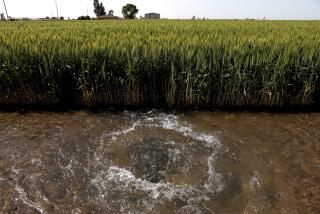San Clemente City Council Passes Region’s Toughest Water-Use Law
- Share via
SAN CLEMENTE — The City Council Wednesday unanimously approved a water-rationing law that would take effect during dry spells and threaten violators with fines of up to $100 in what is the toughest measure of its kind in Southern California.
The law, part of a package of water conservation and engineering study measures that passed on a 5-0 vote, will not only limit residential uses such as lawn-watering and car-washing, it also will ban the use of water in large construction sites during the dry summer season.
“At this point, it’s important to take a stand and do whatever we can to conserve water,” said Councilman Scott Diehl. “We need to move on this as rapidly as possible.”
The rationing law was proposed after severe shortfalls occurred during the summer. Also prompting the action was a prediction that the city may require as much as 20% more water next year and that it probably will not receive more from the Tri-Cities Municipal Water District, its wholesaler, than it received this year.
In fact, in a meeting before the council session, the Tri-Cities board approved a “water delivery schedule” that limits next year’s sales to 1989 levels.
Tri-Cities general manager Ray Woodside stressed that the schedule is not a strict water allocation plan, but he did say that he expects the district’s four customers--San Clemente, Capistrano Beach, San Onofre State Park and the San Onofre Nuclear Power Generating Station--to comply with the maximums in the delivery schedule outlined in the two-page document. San Clemente uses about 66% of the water supplied by the district.
The San Clemente ordinance calls for a “conservation period” effective between June 15 and Sept. 15, 1990. During that time, lawn watering and other residential irrigation will be permitted only on odd or even days, with the days determined by residents’ addresses. Further, residents will be limited to no more than 510 gallons a day total.
Two employees will be responsible for monitoring commercial water usage, and water meters will be read weekly.
Developers are prohibited from using potable water during grading and are required to treat exposed slopes with anti-erosion materials before planting.
Should the water level in the district’s 48-million-gallon reservoir fall below 35 million gallons, even tougher standards will be applied.
Some council members began pressing the district to order a water allocation plan after city officials backed away from passing a water rationing ordinance in August.
The water delivery schedule amounts, in effect, to a water allocation plan, said former San Clemente Mayor Karoline Koester, who has been urging the council to pass a water-rationing plan.
She was critical of the district’s schedule, however, because it contains no enforcement provision. Woodside said that he does not know what would happen if a water customer exceeded its maximum water allocation. “We’ll have to see when and if we get to that point,” he said.
The issue has been the subject of debate since early summer, when water levels in the district’s reservoir fell dangerously low, creating the district’s most severe water crisis in recent memory.
The level dipped to 34 million gallons July 1, prompting water district officials to urge customers to begin taking conservation measures, but it was at 17 million gallons on Aug. 18. The level is now above 47 million gallons, Woodside said.
Tri-Cities officials have criticized the San Clemente council for not moving swiftly to implement a water-rationing law during that period, and last month, Woodside criticized the council for deferring action on the proposed ordinance.
The council at its Aug. 30 meeting refused to enact a mandatory water-rationing measure after some members argued that it might seem too harsh to residents who had been cutting back on their water usage voluntarily.
The shortfall occurred in the Tri-Cities reservoir because the supply was being used faster than the district could replenish it.
City officials maintain that the water crisis eased because of their urging residents to save water, but Woodside says that the water level rose because there is less water usage in the fall.
Voluntary water rationing “had nothing to do with it,” Woodside said.
More to Read
Sign up for Essential California
The most important California stories and recommendations in your inbox every morning.
You may occasionally receive promotional content from the Los Angeles Times.













